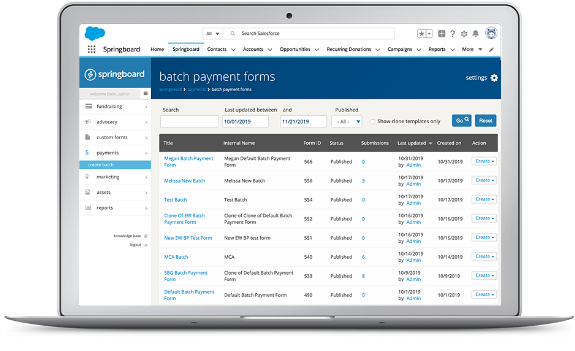Becoming a Digital-First Organization

Fifteen years ago, "online" was the big buzzword in the nonprofit sector. Online advocacy. Online fundraising. Online communications. It was all about engaging your constituents online. Of course, all this was done in parallel to the traditional offline efforts, which included direct mail, phone fundraising, print ads, and more.
Then new buzzwords entered the mix—social, mobile, and data-driven, to name a few. Each of these concepts developed independently, and led to your direct mail people, phone fundraisers, print ad folks, web team, and social marketers all doing their jobs separately. Not surprisingly, nonprofits have organized themselves into separate channels and silos, and are left scrambling to do it all and keep up. These organizational divisions are reflected in how campaigns are structured, budgets are made, technology is purchased, and strategies are created. Unfortunately, these internal silos negatively impact the way that nonprofits communicate with their audiences. Instead of showing the forest, they engage their supporters with the trees.
Well, that notion of "online" has evolved considerably, as have your supporters’ expectations. Today, audiences now anticipate personalized, end-to-end interactions where they are recognized across channels and communicated with on their terms. They no longer simply want to be acknowledged as individuals; they expect to be treated as individuals. This tailored approach is the most effective way to keep these people—arguably your organization’s most valuable assets—engaged and loyal.
Yet, despite this shift in expectations and need for nonprofits to adapt accordingly, we still hear far too many organizations obsessing about specific channel approaches. Do we need a Snapchat strategy? Should we run a tweet-to-give campaign? This narrow vision must be replaced by bigger-picture, multi-channel engagement goals in order to position an organization for long-term success. It’s critical for nonprofits to embrace a more modern, durable model if they’re going to stay relevant.
It’s time for a Digital First approach.
What Is Digital First?
Instead of starting with channels, mediums, and devices, Digital First is a methodology—a new way of thinking and working. Digital First acknowledges that the digital landscape, and your audiences’ expectations, will always be changing. It supports this dynamic environment by offering a framework for how modern organizations need to evolve their cultures; evaluate strategy; organize their teams; create internal processes; and support these activities with flexible, innovative technology. When implemented effectively, a Digital First approach can have a transformational impact on organizations—from improving supporter engagement and programmatic work to strengthening the nonprofit’s ability to fulfill its mission.
But Why Digital First?
For most organizations, digital touches everything. The staff formerly known as the Web team or the Online Fundraising team—even teams of one!—are being assigned increasingly greater responsibilities: educating senior staff on digital best practices; managing an average of 8-15 digital properties; evaluating new communications opportunities; co-owning the housefile; making major technology decisions; and garnering insights from critical campaign efforts. Staff across the organization are becoming savvier and more demanding digital stakeholders. In parallel, they’re being asked to contribute more as bloggers, tweeters, and public extensions of the organization’s brand.
What Does it Take to Become a Digital-First Organization?
“Real digital transformation involves the entire organization. It involves people and culture as much as—or perhaps more than—it involves technology.” (Information Week)
While the path to get there looks different depending on where you’re starting, we’ve consistently observed five hallmarks of aspiring Digital First organizations.
- Digital is core to their strategy—at all levels of the organization
The most forward-thinking organizations use digital as more than a communications medium. They employ digital disciplines as a methodology for leadership, consensus-building, and collaboration between departments. They create seats for digital staff at the planning table, making a multi-channel approach central to everything in the organization from top to bottom: from supporter engagement, to service delivery, to the organization’s overall theory of change. They think of “digital” as a platform for doing more and better work in the world. And they expect that their strategy will be regularly informed by analysis and data that brings them closer to their audiences and helps them to refine their approach to their program work too.
- All staff are digital staff
Whether it’s how program staff provide services or share their work, how HR recruits, or how leaders/experts build their brand, the reality is that “digital” intersects the work of all staff in an organization. Because digital skills aren’t in everyone’s wheelhouse, it is the responsibility of the in-house digital expert(s) to up-level the entire organization’s knowledge of best practices, providing guidance about what is possible or advisable, and why.
The long-term goal in Digital First nonprofits is that everyone—at all levels—is talking and thinking across channels, from upstream planning to downstream campaign implementation.
- Opportunities are prioritized through strong processes
A Digital First approach is not easy on process, mainly because it means the possibilities to reach your audiences are endless. And since it is impossible to do and be everything to everyone, you have to prioritize (see #1: strategy). You must have a framework for decision-making based on broader organizational objectives, so that you can deliberately pursue the communications, marketing, fundraising, and advocacy opportunities that best align with your organization’s mission.
Part of good process involves having regular (at least weekly) forums to evaluate opportunities against priorities, and then communicate the outcomes or decisions and the “why” to your broader teams. The frequency of such evaluations will enable you to quickly implement new tactics or to shift directions based on what’s working or failing—according to objective, data-informed criteria. Don’t underestimate the importance of analytics!
- They embrace modern technology
For better or worse, your supporters’ expectations have been shaped by for-profit companies with big budgets and sophisticated technology. Concepts like marketing automation have set the standard for real-time, personalized interactions, and endless ways to engage with an organization.
Digital First organizations use new digital technology to track audience behaviors, measure engagement across channels, and optimize their efforts, thereby gaining valuable insights into supporters’ attitudes, motivations, needs, and goals. They build comprehensive audience profiles to become more in-tune with their audience’s expectations. And then they use these insights to tailor their technology and tactics, creating more automated supporter services, such as stage-specific content and engagement opportunities.
- Experimentation and risk-taking is valued (or at least tolerated!) in their culture
Digital First organizations have staff who keep an ear to the ground and a finger on the pulse of what’s happening outside their nonprofit’s walls. While they know that every new medium doesn’t need a discrete strategy, they know who their organization is trying to reach, and they are empowered to experiment with new methods, tactics, and messages to make those connections. Unlike the early days of the Web, which featured tightly-controlled content and heavy moderation, Digital First organizations accept some inherent risk in participating in fast-moving environments.
Above all, Digital First nonprofits are learning organizations. They use their communications channels as places to experiment, to see what resonates, and to grow their internal knowledge of effective ways to reach supporters. They track what worked and analyze what didn’t, and then report the insights back to their entire team. From the executive level to staff on the ground, the organizational culture needs to embrace—or at least have a high tolerance for—the value of trying out new ideas.
Can Your Nonprofit Transform Into a Digital First Organization?
Yes! Regardless of your organization’s size or resources, a shift towards Digital First takes time, effort, and commitment. We’ve been lucky to partner with the Natural Resources Defense Council (NRDC) for the past several years as they’ve embarked on a Digital First transformation, moving away from their fragmented approach to communications by implementing a refined brand, team structure, process, content strategy, and new website.
Join NRDC’s Deputy Director of Marketing and Engagement, Michelle Egan, and Jackson River CEO, Alice Hendricks, to learn more about Digital First and hear NRDC’s story at our upcoming webinar, The Modern Digital Team, on July 13 at 11 a.m. PT / 2 p.m. ET. Register today.
This piece was originally published on the Nonprofit Technology Network (NTEN) blog.

